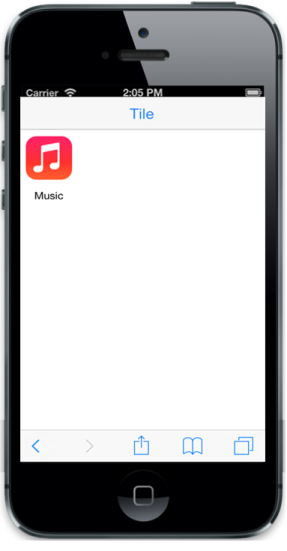Image configuration
20 Feb 20173 minutes to read
The data-ej-imageposition attribute is used to adjust the position of the Tile image. It accepts the following values.
-
center
-
topcenter
-
bottomcenter
-
rightcenter
-
leftcenter
-
topleft
-
topright
-
bottomright
-
bottomleft
-
fill
The data-ej-backgroundcolor attribute is used to set the background color of the Tile.
The data-ej-imageurl attribute is used to specify the file name for the background image of the Tile. The data-ej-imagepath attribute is used to define the root path that should contain the following folder structure to automatically render the background image based on the device/platform it gets rendered. All these three folder should contain the image files (with same name, but different images) that can be specified in the image url property.
-
iOS7 - Folder name for ios7 specific images
-
Android - Folder name for Android specific images
-
Windows - Folder name for Windows specific images
NOTE
Both
data-ej-imagepathanddata-ej-imageurlattribute can be set when you want to specify separate images for each render mode and so it is necessary to specify separate path for iOS, android and windows renderMode. Whendata-ej-imageurlattribute is alone used, you can provide common images for all render modes. So, you should provide the whole image path for this attribute.
<div id="header" data-role="ejmnavigationbar" data-ej-mode="header" data-ej-title="Tile" data-ej-titlealignment="center" data-ej-position="top" data-ej-touchend="tileSelection">
</div>
<div class="tiles" style="top: 45px; position: relative;">
<div id="tileview1" data-role="ejmtile" data-ej-showroundedcorner="true" data-ej-imageposition="fill" data-ej-caption-position="outer" data-ej-caption-alignment="center" data-ej-tilesize="small" data-ej-imagepath="../themes/sampleimages/tileview/" data-ej-caption-text="Settings" data-ej-imageurl="setting.png">
</div>
</div>The following screenshot displays the output of the above code.

Also you can give images for each Tile through CSS classes by using the data-ej-imageclass attribute. You can define your desired styles in the specified class.
Refer to the following code example.
<div id=" header " data-role="ejmnavigationbar" data-ej-mode="header" data-ej-title="Tile" data-ej-titlealignment="center" data-ej-position="top" data-ej-touchend="tileSelection">
</div>
<div class="tiles" style="top: 45px; position: relative;">
<div id="tileview1" data-role="ejmtile" data-ej-showroundedcorner="true" data-ej-imageposition="fill" data-ej-imageclass="imageclass" data-ej-caption-position="outer" data-ej-caption-alignment="center" data-ej-tilesize="small" data-ej-caption-text="Settings">
</div>
</div>Refer the below code snippets for CSS classes
.imageclass {
background-image: url("../themes/sampleimages/tileview/ios7/setting.png");
}The following screenshot illustrates the output of the above code.
